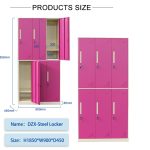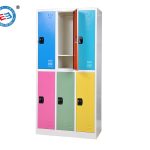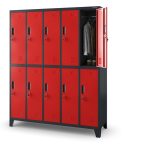With the booming development of the fitness industry, more and more people head to gyms for workouts, and gym lockers, which are essential facilities in every gym, play a crucial role in storing personal belongings. To protect the members' valuables, the type of lock used in lockers becomes a key factor. Currently, gym lockers primarily use two types of locks: electronic locks and mechanical locks. Each type has its advantages and disadvantages, and selecting the right lock is important for both the gym’s service quality and the members' experience.
Electronic Locks:
Electronic locks, which have become increasingly popular in gyms in recent years, stand out due to their smart features and convenience. These locks use methods such as passwords, fingerprints, RFID cards, or mobile phone Bluetooth to unlock, eliminating the need to carry traditional keys. Let’s take a closer look at the characteristics of electronic locks:
Advantages:
1. High Security: Electronic locks typically have multiple security mechanisms, such as password resets and fingerprint recognition, which make them harder to break. Compared to traditional mechanical locks, they offer better protection, reducing the risk of theft.
2. Convenience: Users can unlock electronic locks by entering a password, scanning a card, or using their phone app. There’s no need to worry about losing or forgetting a key. Many high-end gyms even provide an app that connects to the locker system, allowing users to handle everything via their phones.
3. Traceability: Some electronic locks come with recording functions that track locker usage, improving management efficiency. In case of theft, gym management can review unlocking records to help investigate the issue.
4. Avoid Key Loss: Unlike traditional mechanical locks, electronic locks don’t require physical keys, preventing the inconvenience caused by losing keys.
Disadvantages:
1. Higher Cost: Installing and maintaining electronic locks is relatively expensive, which can increase the operational costs of the gym. This might concern smaller gyms with limited budgets.
2. Battery Issues: Electronic locks require batteries to function. If the battery runs out, the lock may become inoperative. Therefore, gyms need to regularly check the battery status to ensure proper functioning.
3. Technical Failures: Electronic locks may malfunction due to circuit problems, software issues, or external interference, which might prevent users from unlocking them. In such cases, the system may require repairs or replacements.
Mechanical Locks:
In contrast to electronic locks, mechanical locks are the traditional form of lock used in gym lockers. These locks rely on mechanical components such as keys or dial combinations to lock and unlock. Despite being more traditional, mechanical locks still have many supporters due to their simplicity and stability.
Advantages:
1. Stable and Reliable: Mechanical locks do not rely on batteries or electronic components, making them more stable and less prone to malfunctions. They offer reliable long-term use, especially in gyms with continuous operation.
2. Lower Cost: Compared to electronic locks, mechanical locks are cheaper to install and maintain, making them a better option for gyms with a limited budget.
3. No Power Dependency: Mechanical locks do not require external power or batteries, so gym members don’t have to worry about battery replacement, avoiding the issues faced with electronic locks.
Disadvantages:
1. Lower Security: Traditional mechanical locks, such as those with keys or dial combinations, can be more easily manipulated or broken into by thieves, making them less secure than electronic locks, particularly if the gym management is lax.
2. Less Convenient: Users need to carry keys or remember combinations. If they lose the key or forget the code, it can cause significant inconvenience. Furthermore, mechanical locks are more cumbersome to use, making them less convenient than electronic locks.
3. Poor Management: Mechanical locks do not have tracking functions, so gym management cannot monitor locker usage. If theft or loss occurs, it’s difficult to trace responsibility.
Which lock is suitable for gym lockers?
The choice of electronic lock or mechanical lock for gym lockers depends on specific needs:
Size and Budget:
For large gyms or high-end fitness clubs, electronic locks may be the better choice, offering higher security and enhanced user experience. On the other hand, for smaller gyms with limited budgets, mechanical locks provide a more cost-effective option.
Security Needs:
If the gym members store high-value items, or if the area is considered to be less secure, electronic locks offer better safety. With advanced security features, electronic locks can enhance the overall safety of the lockers.
Usage Frequency and Convenience:
If gym members frequently use lockers, electronic locks provide a more convenient unlocking experience, especially for users who prioritize convenience. For gyms with less frequent locker use, mechanical locks may be a simpler and more affordable choice.
Conclusion
Both electronic and mechanical locks have their advantages and disadvantages. Electronic locks offer higher security and convenience, making them ideal for large gyms and high-end members, while mechanical locks are more cost-effective and stable, suited for gyms with limited budgets or fewer demands for smart features. Choosing the appropriate lock based on the gym's specific needs maximizes the protection of members' belongings and improves the overall service quality.





